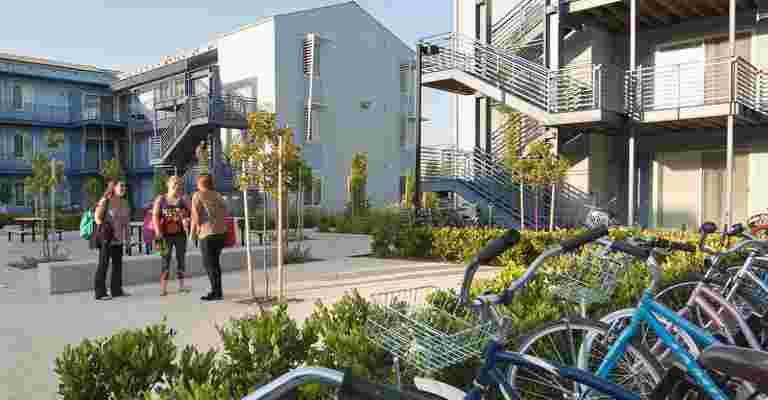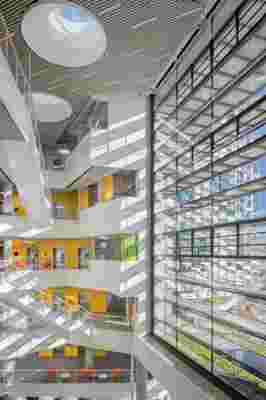This Is What Architects Should Do to Help Fight Climate Change
As Hurricane Ida slowly went back out to sea in September, having lumbered its way from the Gulf Coast to New England (and having caused over 100 deaths and nearly $100 billion in damages), one of its closing acts was a stunning explosion of a single-family house in New Jersey. The cause: a gas stove. Having been dislodged by rising waters, this kitchen appliance introduced a gas leak, resulting in the explosion that reverberated across the neighborhood. Dramatic though it was, the blast was by no means exceptional. Every year, the U.S. sees almost 300 serious natural gas explosions, killing, on average, 15 people per year.
Explosions from natural gas are one thing, but scientists, economists, public health advocates, and policy makers have also been eyeing the invisible—invisible, but no less dangerous—systemic risks that natural gas carries as a source of greenhouse gas emissions. “Gas is a huge contributor to climate change,” says Adam Roberts, director of policy at the American Institute of Architects New York. “It’s better than coal or oil, but, still, we are at a point where we just don’t need fossil fuel–powered buildings anymore.”
As Rachel Golden, a principal of the carbon-free buildings team at the Rocky Mountain Institute quantifies it, “there are 70 million buildings that burn gas, oil, or propane, which results in 600 million tons of greenhouse gasses.” With the methane leakage that occurs during drilling and piping, that figure surges upward even more. “Globally,” she adds, “buildings account for 35% of greenhouse gasses.”
Looking to address the causes of climate change stemming from their own profession, architects are increasingly moving toward what those in the industry call building electrification. By drawing a building’s energy entirely from electrical infrastructure, architecture, once that infrastructure becomes powered by renewable sources, can more readily position itself as a net-zero proposition. In the nearer term, as grids transition, building electrification provides an alternative to gas-powered buildings, mitigating energy loads and lessening emissions.
Already, some architects are proactively anticipating the eventuality of a renewable-powered grid. “The electric grid is becoming greener,” says architect Bill Ryall, who has designed a series of high-performance homes across the U.S. “With all-electric buildings that plug in,” he adds, “we can avoid building fossil fuel dependence into new or renovated buildings.”

University of California Davis’s West Village neighborhood is the largest “zero net energy” community in the U.S., generating as much energy as it consumes.
With natural gas prices so low—thanks, in part, to generous subsidies and a history of favorable policies—the shift to renewables has been halting. University campuses have been an exception, knowing they stand to benefit from long-term investments in energy.
“Because these institutions think in both long- and short-term contexts, they have been able to lead the way with their approach to energy,” explains Behnisch Architekten partner Robert Matthew Noblett, who is currently designing campus projects for an eventual transition to all-electric energy. “As soon as we can summon the collective political will to broaden the infrastructure of renewable energy, building owners can then convert these buildings to electricity,” he adds.

Harvard University’s John A. Paulson School of Engineering and Applied Sciences, designed by Behnisch Architekten, received LEED Platinum and Living Building Challenge Petal certification.
Increasingly, private and commercial clients across different building types are looking to electrify too. In Brooklyn, Alloy, a firm that combines both architecture and real estate development, is embarking on the construction of a 44-story mixed-use tower, which, once complete, will become New York City’s first fully electric residential tower.
The firm was committed to reducing their own company’s carbon footprint as a general principle, and, with New York State moving toward carbon neutrality for its electrical grid by 2050, the tower will be free from fossil fuels. But as developers, they were mindful of the economics of their all-electric proposal too. In assessing the changing landscape of energy credits, Alloy vice president Jeff Sullivan says, “our building will quickly become more cost-effective from a carbon credit perspective.”

Alloy Block, Alloy’s all-electric tower in Brooklyn, is expected to be complete in 2024.
Like so much else in current discourse across the U.S., the challenge of renewable energy policy hinges on the fraught balance between government regulation on the one hand and laissez-faire markets on the other. But as the science of gas-powered buildings becomes clearer, the regulatory environment is changing, and cities and states are busy establishing future dates for carbon neutrality.
“Fully renewable energy is ultimately our future,” says Snøhetta director Aaron Dorf. “The only variable is how fast we get there.” To quicken that eventuality, Snøhetta has been pushing forward on projects that not only reduce energy use to zero, such as the HouseZero for the Harvard Center for Green Buildings and Cities, but that also produce more energy than they consume.
One of the chief obstacles in moving away from a reliance on fossil fuels in architecture is the generalist nature of the profession itself. As Golden explains, “buildings are such a huge factor in climate change, but they haven’t received the attention they deserve from policy makers because the industry is so disaggregated.”
There is also the issue of addressing both the operational side of the challenge (gas-powered furnaces and water heaters account for most outdoor pollution) and the experience of the end users (“Gas cooking is often the last thing that clients will give up,” Ryall says).
As architects design buildings and systems that move away from fossil fuels, consumers are changing their expectations, too, as advances in induction cooktops make electric options more appealing. “Gas is primordial—you feel it, see it, smell it—like a manual transmission in a car,” says Skyler Stevenson, a senior product manager of Gaggenau North America, which offers a line of induction cooktops. “But induction is like the automatic transmission—it does everything more efficiently and effortlessly, and with far more precision and safety.”
Public health research promises to tilt that scale even further, as the science of indoor air quality becomes clearer and the reality of having gas lines coursing through homes seems more needlessly hazardous. Rachel Golden points out that children living in homes with gas stoves are 42% more likely to suffer from asthma.
The data can be alarming, but for groups like Rocky Mountain Institute and AIANY, which have been long active in pushing for fossil fuel–free architecture, and for a growing cohort of architects and clients, electrification has become just plain common sense. “We have become so used to living in a world where we have to remember to turn the gas off, and where we live with pilot lights and the health and safety risks of having gas in our homes,” says Roberts, of AIANY. “But it just doesn’t have to be that way.”